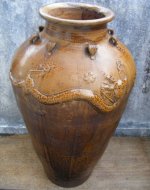Upvote
5
Navigation
Install the app
How to install the app on iOS
Follow along with the video below to see how to install our site as a web app on your home screen.
Note: This feature may not be available in some browsers.
More options
You are using an out of date browser. It may not display this or other websites correctly.
You should upgrade or use an alternative browser.
You should upgrade or use an alternative browser.
Old Vase or a water Jug (Antique)
- Thread starter Jenjen21
- Start date
Red-Coat
Gold Member
Very nice. Those are ‘Martaban’ jars from Southern China and perhaps from the late 1700s or early 1800s. Older examples and more recent copies exist however. They take their name from the Burmese port on the gulf of Pegu through which many of them were traded throughout SE Asia and beyond. They were made near port towns, principally in the southern Chinese coastal provinces of Kwangtung, Fukien and Chekiang. The encircling dragon (Naga) decoration on stoneware with black, dark-brown or amber glaze is very typical. They range in size from around 30 inches or more down to about 12 inches.
They were originally used as storage jars for provisions such as oil, wine, fruits, and pickles as well as serving as shipping containers for more delicate and expensive ceramics wrapped or packed in sawdust/wood-shavings. This one, very similar to yours, is described by the seller as a rare antique (c.1800) 32-inch high ‘Tajau Dayak circling Naga’ for which he wants $1200.

That’s a credible description, but (presumably) undocumented with respect to provenience/provenance and may be a way of bumping up the price to that level. The Dayak (of Borneo) were one of a number of tribal peoples throughout the Malaysian and Indonesian island regions who valued the empty jars as prestige items. They used the term ‘pusaka/pesaka’ and other dialect variations to describe them. In Borneo, the term was usually restricted to jars passed down through a family as heirlooms and regarded as sacred. But they were also used as a form of currency for ‘bride-price’ at weddings and to validate peace agreements between tribes, or as reparation for deaths arising from territorial disputes.

Five jars described as sacred from the district head of Pangkoh, a Ngaju village on the Kahayan River (South Borneo, Dutch East Indies), c.1915. Copyright: Tropenmuseum, Amsterdam. Coll. no. 10001019.
Do yours have any marks on the base? That might both help attribute or date them, or elevate their value. Unless there are marks which suggest greater antiquity, and without demonstrable proof for subsequent tribal use, generic large jars of this type from the 1800s have a start price around $200 but frequently fetch significantly more.
They were originally used as storage jars for provisions such as oil, wine, fruits, and pickles as well as serving as shipping containers for more delicate and expensive ceramics wrapped or packed in sawdust/wood-shavings. This one, very similar to yours, is described by the seller as a rare antique (c.1800) 32-inch high ‘Tajau Dayak circling Naga’ for which he wants $1200.

That’s a credible description, but (presumably) undocumented with respect to provenience/provenance and may be a way of bumping up the price to that level. The Dayak (of Borneo) were one of a number of tribal peoples throughout the Malaysian and Indonesian island regions who valued the empty jars as prestige items. They used the term ‘pusaka/pesaka’ and other dialect variations to describe them. In Borneo, the term was usually restricted to jars passed down through a family as heirlooms and regarded as sacred. But they were also used as a form of currency for ‘bride-price’ at weddings and to validate peace agreements between tribes, or as reparation for deaths arising from territorial disputes.
Five jars described as sacred from the district head of Pangkoh, a Ngaju village on the Kahayan River (South Borneo, Dutch East Indies), c.1915. Copyright: Tropenmuseum, Amsterdam. Coll. no. 10001019.
Do yours have any marks on the base? That might both help attribute or date them, or elevate their value. Unless there are marks which suggest greater antiquity, and without demonstrable proof for subsequent tribal use, generic large jars of this type from the 1800s have a start price around $200 but frequently fetch significantly more.
Last edited:
Top Member Reactions
-
 3349
3349 -
 1900
1900 -
 1862
1862 -
 1163
1163 -
 1092
1092 -
 876
876 -
 838
838 -
 831
831 -
 823
823 -
 774
774 -
 767
767 -
 541
541 -
 518
518 -
 497
497 -
 438
438 -
 428
428 -
E
417
-
 402
402 -
 396
396 -
 396
396
Users who are viewing this thread
Total: 2 (members: 0, guests: 2)



